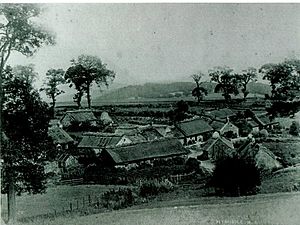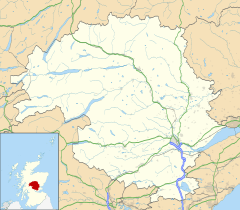Pitmiddle facts for kids
Quick facts for kids Pitmiddle |
|
|---|---|
 Pitmiddle around the turn of the 20th century, looking east-northeast towards Knapp |
|
| OS grid reference | NO 24419 29651 |
| Council area | |
| Lieutenancy area | |
| Country | Scotland |
| Sovereign state | United Kingdom |
| Post town | PERTH |
| Police | Tayside |
| Fire | Tayside |
| Ambulance | Scottish |
| EU Parliament | Scotland |
Pitmiddle was a small village in the Gowrie area of Perthshire, Scotland. It is now empty, with the last person leaving in 1938. Not much is left of the village today. Its history goes back to the 1100s, and it is now a special protected historical site called a scheduled monument.
Contents
What's in a Name?
The first name for Pitmiddle was Petmeodhel. The word pet comes from the Pictish language and means 'piece of land'. We don't know for sure what meodhel means, but it might have meant 'soft ground'.
Where Pitmiddle Was Located
Pitmiddle was about 0.5 miles (0.8 km) north of Kinnaird. It was once a busy village on top of a hill, home to hundreds of people. However, its remote location eventually led to it being left empty. The hills around it, called the Braes of the Carse, reach about 180 meters (590 ft) high.
The village was on a slope looking over the River Tay. It was protected from the south by Guardswell Hill (209 m or 686 ft high) and from the north by Pitmiddle Hill (around 275 m or 902 ft high).
A Look Back at Pitmiddle's History
Pitmiddle was first mentioned in an old document from 1172 to 1174. In this document, William the Lion, who was the King of Scotland, gave land to Ralph Rufus. But he kept Pitmiddle for his clerk, Richard. This shows that Pitmiddle and Kinnaird were originally lands owned by the king. Pitmiddle belonged to the local lord of Inchmartine for about 150 years.
The village itself was never a large area controlled by one lord, but it was likely treated as a separate part of the larger area of Longforgan.
Life as a Tenant
People living in Pitmiddle had to pay their lord in two ways: cain and conveth. Cain was like a gift to the lord to show respect. Conveth was a payment to cover the lord's stay when he visited his land each year. These payments were often made with goods like food or crops from the land. Some people might have been free to leave, but most were tied to the land and had to work for the lord.
The Ogilvy family owned most of Inchmartine and Pitmiddle in the late 1400s.
Times of Change
Pitmiddle was not involved in the Jacobite risings of 1715 and 1745. These were rebellions by people who supported the old royal family of Scotland. However, the nearby Kinnaird estate was lost after 1715 because its owner supported the Jacobite movement.
Changes in farming methods in the 1700s greatly affected the village. By 1783, two new small settlements were built on Pitmiddle's land. This took away most of Pitmiddle's farming land. These new places were called Newtown (now Outfield) and Bank (now Guardswell).
After the Scottish Reformation, which was a big change in religion in Scotland, Kinnaird became its own separate church area.
Today, if you visit Pitmiddle, you'll find it hidden among farms and woods. The only things left are a few broken walls and wild redcurrant and gooseberry bushes. These bushes once grew in the gardens of the people who lived there. A survey in 2017 found the ruins of nine buildings.
Who Lived in Pitmiddle?
In the 1400s, a man named William Thomassoun lived in Pitmiddle. He was a small but free farmer.
By 1691, about 250 people lived in Pitmiddle and a nearby small village called Craigdallie.
An old map from 1783 shows Pitmiddle as a group of houses that were not neatly arranged. The houses would have been single-story buildings. Their walls were made of wattle-and-daub (woven branches and mud). The roofs were made of turf or thatch, which came from reeds near the River Tay. Each house had one main room for living. One end of the room was often separated for animals. An open fire in the middle of the room provided heat. There might have been a hole in the roof for smoke to escape. People would throw their household rubbish onto a pile near the entrance. Each house also had a small yard where chickens or pigs might roam, and vegetables were grown. A ditch surrounded the settlement, separating it from the farming land.
The main crops grown at Pitmiddle in the 1600s were bere (a type of barley) and oats. These crops were also the main food for the villagers. Later, wheat was also grown.
Pitmiddle is thought to have had a summer pasture for animals on Blacklaw (Black Hill) to the north. By 1609, these areas had become a sheep farm.
In the 1500s, we know of people like Androu Benbie, who was a wright (a person who built things). Another person, Edmund Jackson, was fined for hitting a common shepherd on a Sunday.
More family names are known from the 1600s because more records survived. These names include Anderson, Christal, Morton, Millar, Blair, Mitchell, Duncan, Paterson, Ogilvy, Young, Smyth, Christie, Robertson, Matthew, Thom, Gairdner, Will, Hall, Muir, Pirie, Martine, and Lawson. In 1650, there were nineteen families living there.
In the early 1800s, the homes in Pitmiddle were rebuilt using stone. They were still single-story and had thatched roofs. The floors were made of stone, and fireplaces were built into the end walls. The houses were divided into two rooms by large wooden beds. The kitchen fireplace had hooks for kettles and pans. The 1861 census showed that most homes had two rooms with windows. By 1891, some homes had three rooms, while others still had one or two. Attached to the houses were wooden sheds, byres (cow sheds), and small gardens. The village got its water from three wells.
Even with these new stone homes, Pitmiddle started to decline. It used to be a busy community with weavers, a blacksmith, two joiners, a tailor, a butcher, and a public house. But young people began to leave to find work in factories in nearby Dundee and Perth.
In 1841, just under one hundred people lived in Pitmiddle, in twenty-six households.
In December 1896, two reporters visited Pitmiddle. At that time, seven families lived there. The reporters met Maidie Mitchell and her sister, two very old ladies who had lived in Pitmiddle their whole lives.
By 1897, there were only sixteen people left in the village, which was half the number from six years before.
A sawmill was working in Pitmiddle before 1915. An old map from 1861 shows a "mill dam" southeast of the village.
After the Inchmartine estate was broken up in 1917, the White family bought Pitmiddle. They farmed the land from Outfield. By 1930, only two houses were still lived in. The very last person to live in Pitmiddle was James Gillies Jr. He left his home on January 4, 1938. Winter storms had even stopped the sale of his farm.
Images for kids
-
Pitmiddle around 1900, looking north to Gask Hill. This view was used to create a model of the settlement that was on display at Perth Museum and Art Gallery






